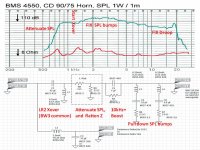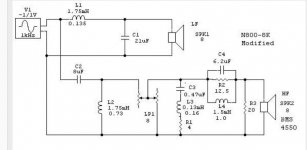Hi guys
I'm using two amps for my horn project, one for the mid/hi which has a passive crossover and the other powers the bass.
The BMS CD's I have a very efficient compared to my bass speaker and amp combo,so I need to pad them down quite a bit. What I thought was a quite amp isn't quite after all.....
Can I just use a series resistor to get the levels matched or do I need to use an L Pad configuration?
If we need an L Pad can we work backwards from a series resistor? eg use the series resistor to get the levels then design an L Pad based on this value.
I've read this isn't good for bass but this is only for the low power mid/hi freq section.
What do you think??
Cheers
I'm using two amps for my horn project, one for the mid/hi which has a passive crossover and the other powers the bass.
The BMS CD's I have a very efficient compared to my bass speaker and amp combo,so I need to pad them down quite a bit. What I thought was a quite amp isn't quite after all.....
Can I just use a series resistor to get the levels matched or do I need to use an L Pad configuration?
If we need an L Pad can we work backwards from a series resistor? eg use the series resistor to get the levels then design an L Pad based on this value.
I've read this isn't good for bass but this is only for the low power mid/hi freq section.
What do you think??
Cheers
Using a pad to solve an amp noise problem is really going to be a waste of power, but let's talk.
An L-Pad is used to attenuate while maintaining the original impedance. The impedance needs to stay constant to avoid affecting the crossover values.
Without the L of the pad, you have an increased impedance, and that changes the necessary crossover values.
Usually calculators let you determine the dB of attenuation, so you don't even have to work this hard. Just figure out how many dB's lower you want your drivers, and what their original impedance is.
However, you may run into more complicated interactions. Ideally what you would do is simulate everything in something like XSim before making any such changes.
Best,
E
An L-Pad is used to attenuate while maintaining the original impedance. The impedance needs to stay constant to avoid affecting the crossover values.
Without the L of the pad, you have an increased impedance, and that changes the necessary crossover values.
Usually calculators let you determine the dB of attenuation, so you don't even have to work this hard. Just figure out how many dB's lower you want your drivers, and what their original impedance is.
However, you may run into more complicated interactions. Ideally what you would do is simulate everything in something like XSim before making any such changes.
Best,
E
Thanks, it's to fix 2 issues really.... Balance drivers and reduce the amp noise floor. The drivers are 114db from memory plus they're on horns so I think I'd be lucky to find a quiet enough amp for a quiet listening room!
Will redo some measurements and see what the exact value of attenuation is required, then use one of the online calculators to figure out values.
Might also run these through xsim and see what it looks like.
But really the answer is use the L Pad.
Thanks
Sent from my Moto G (4) using Tapatalk
Will redo some measurements and see what the exact value of attenuation is required, then use one of the online calculators to figure out values.
Might also run these through xsim and see what it looks like.
But really the answer is use the L Pad.
Thanks
Sent from my Moto G (4) using Tapatalk
You have a special need here. Normally I would want to attenuate before the amp, and use a different amp, but I understand this is the way you want to go.
Using a resistor in parallel with the driver does flatten the impedance somewhat. Unless you are going to attenuate a lot I would still use appropriate tuned filters despite the parallel resistance. The impedance peaks of a compression driver can be tricky to navigate without this help.
With this in mind, you would have the freedom to choose any reasonable load for your amp. This may be one of the few benefits of skewing the series/parallel dominance of the lpad.
Using a resistor in parallel with the driver does flatten the impedance somewhat. Unless you are going to attenuate a lot I would still use appropriate tuned filters despite the parallel resistance. The impedance peaks of a compression driver can be tricky to navigate without this help.
With this in mind, you would have the freedom to choose any reasonable load for your amp. This may be one of the few benefits of skewing the series/parallel dominance of the lpad.
Is the noise floor audible while playing music? I have a lower power DHT amp that whines on warmup, but isn't intrusive when music is playing.
I find amps like these more engaging: amps that are dead quiet seem sterile.
+1 on the LPad - I like the Eminence.
Sent from my Nexus 6 using Tapatalk
I find amps like these more engaging: amps that are dead quiet seem sterile.
+1 on the LPad - I like the Eminence.
Sent from my Nexus 6 using Tapatalk
The engineering investment in EconoWave crossovers has produced a few "favorite low cost" and "favorite fix-all" crossover circuit topologies. For each horn, a study of the BMS 4550 SPL/freq plot will often match the challenges of a proven crossover circuit topology. Attached a couple examples.
If you can measure the BMS 4550 on your horn(or find frd files on-line), and put this frd data file into XSIM, you could try -some of- the "favorite fix-all" crossover circuits with values you calculate with "Passive Crossover Design Calculator" for L-pad, RLC notch filters, RC-treble_boost, etc.
If you can measure the BMS 4550 on your horn(or find frd files on-line), and put this frd data file into XSIM, you could try -some of- the "favorite fix-all" crossover circuits with values you calculate with "Passive Crossover Design Calculator" for L-pad, RLC notch filters, RC-treble_boost, etc.
Attachments
- Status
- This old topic is closed. If you want to reopen this topic, contact a moderator using the "Report Post" button.

